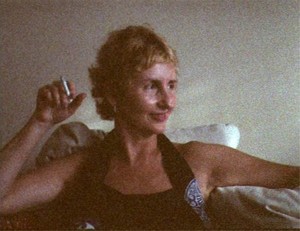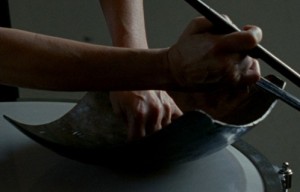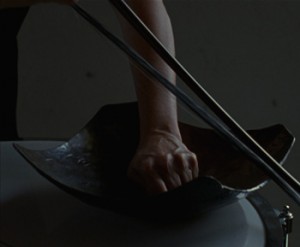What do a Dutch actress best known for her performance in a soft-core porn film that was distributed in mainstream venues, a French-educated, Brazilian psychoanalyst interested in trauma, and an American interpreter of avant garde percussion music have in common? Is that even a worthwhile question to ask about the women who are the subjects of Manon de Boer’s Resonating Surfaces – A Trilogy, on view at the Philadelphia Museum of Art (PMA), extended through May 5, with additional live programming this weekend.

The Dutch actress, Sylvia Kristel, who gained a world-wide reputation for her role as Emmanuelle in the film by that name (and its successors), is the protagonist of Sylvia Kristel – Paris (2003). She has obviously been prompted by a query before the film begins, but we hear only her voice, telling of how her career began and the sequence of men associated with it. She betrays no regrets about the casting couch. de Boer interviewed the actress twice, a year apart, and we hear two versions of her story. But first we see her, a still beautiful femme d’un certain age (as the French so gently put it). She is smoking and lost in thought. Once Krystel begins to talk, the image shifts to a view of Paris. As she reminisces, the scene, never very compelling, moves between fairly distant stills, and the sort of moving image that one sees from a train window. The lack of visual focus and voice-over very effectively capture the quality of memory that underlies the film.

In Resonating Surfaces (2005) Suely Rolnik gives the parallel account of her coming of age in Brazil. As in the earlier film, hers is the only voice we hear, and again, the voice and image are separated. Rolnik was imprisoned under the military dictatorship and went into exile in France. There she studied with Gilles Deleuze, with whom she had a romantic relationship, and Felix Guattari, with whom she underwent analysis. As in the earlier film, de Boer strictly separates Rolnik’s voice from her image. And the landscapes, again, are not very memorable: views of Sao Paolo, intercut with scenes of Rolnik with various friends and family members. (note: The film does not address Rolnik’s involvement in the art world, particularly with the work of Lygia Clark)

Think About Wood, Think About Metal (2011) is Robyn Schulkowsky’s story of how an American percussionist from the Midwest ended up in the center of the avant garde music scene in Germany. She was a young woman in a very male field, but had the good luck to find mentors. De Boer follows Schulkowsky’s hands as she improvises on both conventional instruments and found sources of sound, and creates cinematic parallels with the music. Schulkowsky is the only one of the three subjects whose creative abilities are actually portrayed in the film.
De Boer is clearly interested in how the three women established themselves in a period when women faced more obvious barriers than they do today. There is a sense that she is searching for artistic mother-figures who can offer guides to how a creative woman can make her way. But the films are neither polemical nor prescriptive. They are restrained, first person accounts that examine the way we recount our lives as much as they explore the stories of three particularly interesting women.
On Friday, Feb. 8 at 6:30 pm in the PMA’s Van Pelt Auditorium, Manon de Boer, Robyn Schulkowsky and University of Pennsylvania art historian Karen Beckman will discuss the films with Adelina Vlas, curator of the exhibition. Admission to the talk is free, but tickets are required — click here to reserve tickets. And on Saturday, Feb. 9, 2-4pm, percussionist Schulkowsky will perform in the PMA’s Perlman Building Atrium. Free with museum admission.










